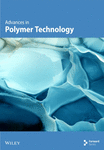Experimental study on injection compression molding of cylindrical parts
Abstract
The control capacity and flexibility of the injection compression molding technique (ICM) is significantly greater than that for conventional injection molding. It thus has potential to produce parts with better dimensional control. This article is devoted to studying the technological application of ICM on the precision molding of cylindrical parts. A modified injection molding machine incorporating a compression mechanism, and a mold with movable wall and shut-off mechanism, are used to investigate the effects of packing and compression on quality in injection-compression–molded polystyrene hollow cylinders. The quality of injection-compression–molded parts is evaluated using roundness, straightness, and birefringence. It has been found that packing is the most effective densification mechanism for cylindrical parts with ring gates. Without proper packing, compression may collapse the frozen layer and degrade the part quality. © 1996 John Wiley & Sons, Inc.




